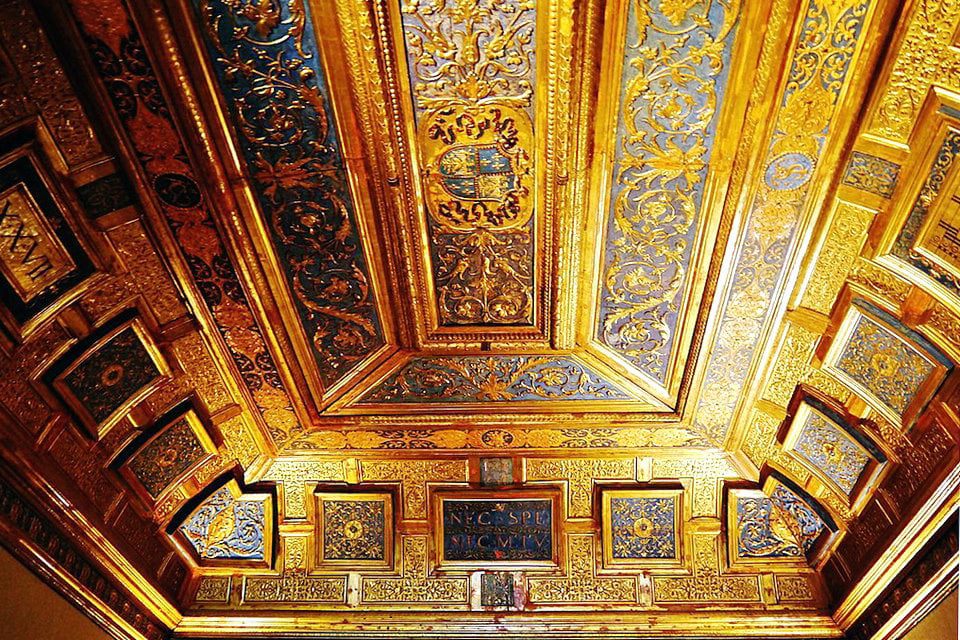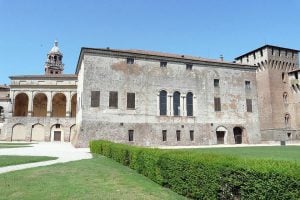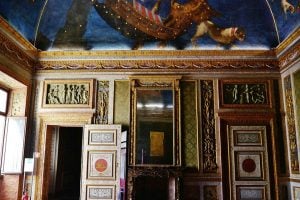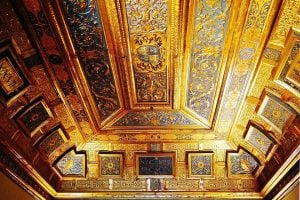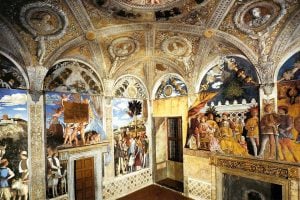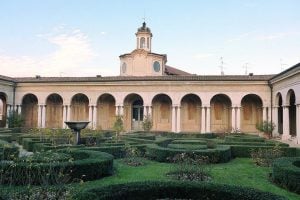Corte Vecchia regained its new prestige when in 1519 Isabella d’Este left the residence in the Castle and moved to the ground floor of this ancient sector of the Gonzaga palace, in the said widow’s apartment. Isabella’s apartment consisted of two wings now divided by the entrance to the Cortile d’Onore. In the more private wing of the Grotto, the wooden furnishings and art collections of the two famous studios, the cave and the study moved with the princess. The latter contained paintings, preserved in the Louvre Museum, from the Studiolo di Castello commissioned between the1496 and 1506 to Mantegna (Parnassus and Triumph of Virtue), to Lorenzo Costa (Isabella d’Este in the kingdom of Harmony and the Kingdom of Como) and to Perugino (Fight between Love and Chastity) to which were added works by Correggio (Allegory of vice and Allegory of virtue). Another famous setting of this wing is the “Camera Granda” or “Scalcheria” frescoed in 1522 by the Mantuan Lorenzo Leonbruno. The apartment included other rooms in the “Santa Croce” wing from the name of an ancient church of the Matildic era on the ruins of which representative rooms were obtained such as the Sala delle Imprese Isabelliane, the Imperial Room or Sala del Camino, the Sala delle Calendule, the Sala delle Targhe and the Sala delle Businesses.
Santa Croce Vecchia was a small church, as it was used in the historical period at the turn of the year one thousand. Its existence is testified by a document dated 10 May 1083 signed by Matilde di Canossa. Adjacent to the first buildings of the future Ducal Palace, it was probably the Palatine Church of the Bonacolsi and Gonzaga families, but the well-known building passion of the latter family led to the demolition of the ancient building. Duly authorized by Pope Martin V, it was Gianfrancesco Gonzaga who proceeded to demolish the old Matildic church around the year 1421which, by way of compensation, near the original place, built a chapel of late Gothic style with the same name, now no longer a place of worship, however, although largely remodeled, identifiable from the small courtyard to the widow’s apartment of Isabella d’Este.
Subsequently Guglielmo Gonzaga (1550 – 1587), will transform the environments of Corte Vecchia creating the Refectory overlooking the Hanging Garden and the Galleria degli Specchi destined to music.
Isabella d’Este
Isabella d’Este (19 May 1474 – 13 February 1539) was Marchioness of Mantua and one of the leading women of the Italian Renaissance as a major cultural and political figure. She was a patron of the arts as well as a leader of fashion, whose innovative style of dressing was copied by women throughout Italy and at the French court. The poet Ariosto labeled her as the “liberal and magnanimous Isabella”, while author Matteo Bandello described her as having been “supreme among women”. Diplomat Niccolò da Correggio went even further by hailing her as “The First Lady of the world”.
She served as the regent of Mantua during the absence of her husband, Francesco II Gonzaga, Marquess of Mantua, and the minority of her son, Federico, Duke of Mantua. In 1500 she met King Louis XII of France in Milan on a diplomatic mission to persuade him not to send his troops against Mantua.
She was a prolific letter-writer and maintained a lifelong correspondence with her sister-in-law Elisabetta Gonzaga. Lucrezia Borgia was another sister-in-law; she later became the mistress of Isabella’s husband. She was described as having been physically attractive, albeit slightly plump; however, she also possessed “lively eyes” and was “of lively grace”.
Isabella d’Este grew up in a cultured family in the city-state of Ferrara. She received a fine classical education and as a girl met many famous humanist scholars and artists. Due to the vast amount of extant correspondence between Isabella and her family and friends, her life is unusually well documented. She was born on Tuesday 19 May 1474 at nine o’clock in the evening in Ferrara, to Ercole I d’Este, Duke of Ferrara, and Eleanor of Naples. Eleanor was the daughter of Ferdinand I, the Aragonese King of Naples, and Isabella of Clermont.
One year later on 29 June 1475, her sister Beatrice was born, and in 1476 and 1477 two brothers, Alfonso and Ferrante, arrived. In 1479 and 1480 two more brothers were born; they were Ippolito and Sigismondo. Of all the children, Isabella was considered to have been the favourite.
In the year of Ferrante’s birth, Isabella travelled to Naples with her mother. When her mother returned to Ferrara, Isabella accompanied her, while the other children stayed behind with their grandfather for eight years. It was during the journey with her mother that Isabella acquired the art of diplomacy and statecraft.
Education
Isabella was a very well educated young woman. As a child she studied Roman history and rapidly learned to translate Greek and Latin (the former would become her favourite language). Because of her outstanding intellect, she often discussed the classics and the affairs of state with ambassadors. Moreover, she was personally acquainted with the painters, musicians, writers, and scholars who lived in and around the court. Besides her knowledge of history and languages, she could also recite Virgil and Terence by heart. Isabella was also a talented singer and musician, and was taught to play the lute by Giovanni Angelo Testagrossa. In addition to all these admirable accomplishments, she was also an innovator of new dances, having been instructed in the art by Ambrogio, a Jewish dancing master.
Betrothal and marriage
In 1480, at the age of six, Isabella was betrothed to Francesco, the heir to the Marquess of Mantua, for a dowry of 25,000 ducats. Although he was not handsome, Isabella admired him for his strength and bravery; she also regarded him as a gentleman. After their first few encounters she found that she enjoyed his company and she spent the next few years getting to know him and preparing herself to be the Marchioness of Mantua. During their courtship, Isabella treasured the letters, poems, and sonnets he sent her as gifts.
Ten years later on 11 February 1490, at age 15, she married Francesco by proxy, who had by then succeeded to the marquisate. Isabella became his wife and marchioness amid a spectacular outpouring of popular acclamation and a grand celebration that took place on 15 February. Besides being the Marquess, Francesco was also Captain General of the armies of the Republic of Venice. She brought as her marriage portion the sum of 3,000 ducats as well as valuable jewellery, dishes, and a silver service. Prior to the magnificent banquet which followed the wedding ceremony, Isabella rode through the main streets of Ferrara astride a horse draped in gems and gold.
As the couple had known and admired one another for many years, their mutual attraction deepened into love; marriage to Francesco allegedly caused Isabella to “bloom”. At the time of her wedding, Isabella was said to have been pretty, slim, graceful and well-dressed. Her long, fine hair was dyed pale blonde, and her eyes, “brown as fir cones in autumn, scattered laughter”.
Francesco, in his capacity of Captain General of the Venetian armies, was often required to go to Venice for conferences which left Isabella in Mantua on her own at La Reggia, the ancient palace which was the family seat of the Gonzagas. She did not lack company, however, as she passed the time with her mother and with her sister, Beatrice; and upon meeting Elisabetta Gonzaga, her 18-year-old sister-in-law, the two women became close friends. They enjoyed reading books, playing cards, and travelling about the countryside together. Once they journeyed as far as Lake Garda during one of Francesco’s absences, and later travelled to Venice. They maintained a steady correspondence until Elisabetta’s death in 1526.
Almost four years after her marriage in December 1493, Isabella gave birth to her first child out of an eventual total of eight; it was a daughter, Eleonora, whom they called Leonora for short.
Lucrezia Borgia
A year after her marriage to Isabella’s brother Alfonso in 1502, the notorious Lucrezia Borgia became the mistress of Francesco. Isabella had given birth to a daughter, Ippolita, at about the same time, and she continued to bear him children throughout Francesco and Lucrezia’s long, passionate affair, which was more sexual than romantic. Lucrezia had previously made overtures of friendship to Isabella which the latter had coldly and disdainfully ignored. From the time Lucrezia had first arrived in Ferrara as Alfonso’s intended bride, Isabella, despite having acted as hostess during the wedding festivities, had regarded Lucrezia as a rival, whom she sought to outdo at every opportunity. Francesco’s affair with Lucrezia, whose beauty was renowned, caused Isabella much jealous suffering and emotional pain. Their liaison ended when he contracted syphilis as a result of encounters with prostitutes.
Regency
Isabella played an important role in Mantua during the city’s troubled times. When her husband was captured in 1509 and held hostage in Venice, she took control of Mantua’s military forces and held off the invaders until his release in 1512. In the same year, 1512, she was the hostess at the Congress of Mantua, which was held to settle questions concerning Florence and Milan. As a ruler, she appeared to have been much more assertive and competent than her husband. When apprised of this fact upon his return, Francesco was furious and humiliated at being upstaged by his wife’s superior political ability. This caused their marriage to break down irrevocably. As a result, Isabella began to travel freely and live independently from her husband until his death on 19 March 1519.
After the death of her husband, Isabella ruled Mantua as regent for her son Federico. She began to play an increasingly important role in Italian politics, steadily advancing Mantua’s position. She was instrumental in promoting Mantua to a Duchy, which was obtained by wise diplomatic use of her son’s marriage contracts. She also succeeded in obtaining a cardinalate for her son Ercole. She further displayed shrewd political acumen in her negotiations with Cesare Borgia, who had dispossessed Guidobaldo da Montefeltro, duke of Urbino, the husband of her sister-in-law and good friend Elisabetta Gonzaga in 1502.
Cultural pursuits
Isabella d’Este is famous as the most important art patron of the Renaissance; her life is documented by her correspondence, which is still archived in Mantua (c. 28,000 letters received and copies of c. 12,000 letters written).
Art patronage
In painting she had numerous famous artists of the time work for her, including Giovanni Bellini, Giorgione, Leonardo da Vinci, Andrea Mantegna (court painter until 1506), Perugino, Raphael, Titian, Antonio da Correggio, Lorenzo Costa (court painter from 1509), Dosso Dossi, Francesco Francia, Giulio Romano and many others. For instance her ‘Studiolo’ in the Ducal Palace, Mantua, was decorated with allegories by Mantegna, Perugino, Costa and Correggio.
In parallel she contracted the most important sculptors and medallists of her time, i.e. Michelangelo, Pier Jacopo Alari Bonacolsi (L’Antico), Gian Cristoforo Romano and Tullio Lombardo, and collected ancient Roman art.
For what concerns writers, she was in contact with Pietro Aretino, Ludovico Ariosto, Pietro Bembo, Baldassare Castiglione, Mario Equicola, Gian Giorgio Trissino and others.
In music Isabella sponsored the composers Bartolomeo Tromboncino and Marco Cara and played the lute herself. Unusually, she employed women as professional singers at her court, including Giovanna Moreschi, the wife of Marchetto Cara.
In the architecture field, she could not afford new palaces, however she commissioned architects like Biagio Rossetti and Battista Covo.
Being a leader of fashion, she ordered the finest clothing, including furs as well as the newest distillations of perfume, which she concocted herself and sent as presents. Her style of dressing in caps (‘capigliari’) and plunging décolletage was imitated throughout Italy and at the French court.
Relationship with Leonardo’s Mona Lisa
Isabella d’Este has been proposed as a plausible candidate for Leonardo’s Mona Lisa of c. 1503–1506, usually considered a portrait of Lisa del Giocondo. (Lisa was the wife of a merchant in Florence and Giorgio Vasari wrote of her portrait by Leonardo – it remains open whether this is the portrait now known as the ‘Mona Lisa’.) Evidence in favor of Isabella as the subject of the famous work includes Leonardo’s drawing ‘Isabella d’Este’ from 1499 and her letters of 1501–1506 requesting the promised painted portrait; further arguments are the mountains in the background and the armrest as a Renaissance symbol for a portrait of a sovereign.
Potential portrait identifications
Despite her significant art patronage, which included a number of portraits – no other person of her time was so often portrayed – there are very few surviving identified portraits of Isabella. These few identifications are known as inhomogeneous (i.e. differing eye and hair colours as well as divergent eyebrows in both Titian portraits) and there are no images of her between the ages of 26 and 54. It is known that the elderly Isabella preferred idealized paintings and even waived sitting as a model. However, it could be assumed that she still insisted on seeing her personal characteristics in the outcome. Isabelle carefully managed her image. A portrait of her by Andrea Mantegna was rejected because it ‘looked nothing at all like us’. The portrait most probably looked too much like Isabella, who was prone to corpulence.
In recent years several museums have withdrawn their few identifications of portraits as Isabella because of the risk of misidentification. The remaining three colourful portraits are still inhomogeneous (Kunsthistorisches Museum/KHM, Vienna):
Isabella in Red by Titian, c. 1529 (lost, known from a copy by Peter Paul Rubens c. 1605)
Isabella in Black by Titian, 1536
“Ambras Miniature”, 16th century
La Bella (now in Palazzo Pitti, Florence) has been discussed as an alternative to Titian’s 1536 portrait in Vienna, because the commission from the 60-year-old patron was for a rejuvenated portrait; if La Bella were Isabella, eye colour, hair colour, eyebrows and general appearance would homogenize in all known portraits, allowing potential links toward further identifications.
At present the 1495 medal by Gian Cristoforo Romano (several extant copies) is the only reliable identification because of the inscription created during Isabella’s lifetime.
Widowhood
“Devoted head of state”
As a widow, Isabella at the age of 45 became a “devoted head of state”. Her position as a Marquise required her serious attention, therefore she was required to study the problems faced by a ruler of a city-state. To improve the well-being of her subjects she studied architecture, agriculture, and industry, and followed the principles that Niccolò Machiavelli had set forth for rulers in his book The Prince. In return, the people of Mantua respected and loved her.
Isabella left Mantua for Rome in 1527. She was present during the catastrophic Sack of Rome, when she converted her house into an asylum for about 2000 people fleeing the Imperial soldiers. Isabella’s house was one of the very few which was not attacked, due to the fact that her son was a member of the invading army. When she left, she managed to acquire safe passage for all the refugees who had sought refuge in her home.
Later years and death
After Rome became stabilized following the sacking, she left the city and returned to Mantua. She made it a centre of culture, started a school for girls, and turned her ducal apartments into a museum containing the finest art treasures. This was not enough to satisfy Isabella, already in her mid-60s, so she returned to political life and ruled Solarolo, in Romagna until her death on 13 February 1539. She was buried beside her husband in the Church of San Francesco in Mantua.
Legacy
During her lifetime and after her death, poets, popes, and statesmen paid tribute to Isabella. Pope Leo X invited her to treat him with “as much friendliness as you would your brother”. The latter’s secretary Pietro Bembo described her as “one of the wisest and most fortunate of women”; while the poet Ariosto deemed her the “liberal and magnanimous Isabella”. Author Matteo Bandello wrote that she was “supreme among women”, and the diplomat Niccolò da Correggio entitled her “The First Lady of the world”.
Studiolo of Isabella d’Este
The Studiolo was a private space by Isabella d’Este set up in the Ducal Palace of Mantua. Initially located on the noble floor of the castle of San Giorgio, it was transferred in 1523 to the apartments of Corte Vecchia. Isabella was the only Italian noblewoman to have a study, as proof of her fame as a cultured lady of the Renaissance, who preferred intellectual and artistic interests to a hedonistic lifestyle.
History
The first study
Born in Ferrara and educated by some of the most cultured humanists of the time, Isabella married Francesco II Gonzaga in 1490 at the age of sixteen, arriving in Mantua on 12 February of that year. He settled in the apartments on the noble floor of the castle of San Giorgio, not far from the Camera degli Sposi. Shortly after his arrival he had two small rooms of his apartment, poorly lit and without chimneys, organized as rooms for personal use: the “studiolo”, located in the tower of San Niccolò, and the “cave”, a barrel-vaulted roombelow the study, which was accessed via a staircase and a portal decorated in marble. The idea had probably gone both from the knowledge of her uncle Leonello d’Este ‘s Studiolo di Belfiore, and through the acquaintance of her sister-in-law Elisabetta Gonzaga, married to Montefeltro (with whom she had a particular feeling of friendship), after she showed them the studios of Urbino and Gubbio.
Isabella retired to the study to devote herself to her pastimes, to reading, to studying, to correspondence. He also gathered the most valuable pieces of his collections, which initially contained only ancient finds and then also accepted contemporary works, according to that comparison between “ancient and modern” which at the time dominated speculation in the artistic field. He loved to be inspired by poetry, music and art, so much so that he earned the nickname “decima Musa”, and the representations of Muse in fact abounded in the studiolo, both in the canvas by Mantegna and in the reliefs on the portal that led to the cave.
The cave contained the collection of antiquities, while for the study it elaborated at least since 1492 a decorative program based on a series of paintings commissioned to the most illustrious artists of the time, on mythological themes, allegorical deriving from literature and celebrating itself and its house, which were suggested by his advisors, among whom Paride da Ceresara excelled. Isabella’s project, rather original, would have been to put in competition (in “comparison”) the various artists on paintings of identical dimensions, all on canvas, with the same direction of light, which reproduced the natural one of the room, and with the figures in the foreground of the same size. These conditions turned out to be anything but simple to communicate to the various artists, especially if they worked outside Mantua, for the different measuring instruments from city to city and for a certain confusion that generated the same Isabella, often varying and revoking the orders given on subjects and compositions, making mistakes at least once in the direction of the light. Furthermore, not all artists were familiar with mythological and allegorical themes, and in some cases were inhibited by the comparison with Mantegna, the one who started the series, who excelled in such subjects. Emblematic is the case of Giovanni Bellini, who although left free to choose a theme, eventually declined because he was not used to being tied to detailed requests.
A close correspondence remains between Isabella and Perugino, then active in Florence, for the creation of the Struggle between Love and Chastity which allows to reconstruct the method of ordering a painting for the study. The literary theme, specified in all parts, was even included in the notarial contract and included a drawing on which the painter had to base himself. The painter could omit some secondary episode in the highly detailed program, but he was absolutely forbidden to add figures of his own invention or to make changes: when he painted a naked Venus rather than dressed the marquise, through his consultants who continually visited the artist’s studio, he protested vigorously. In 1505, on delivery of the painting, Isabella was not fully satisfied: she said that she would have liked it better if it had been in oil, when instead it had been made in tempera on her explicit instructions to follow the style of Mantegna. All for 100 ducats, well sweated.
Studiolo and grotto soon became one of the most interesting places to show dignitaries visiting the city, with due caution, due to the small size and temptations in which even the best guest could fall: after a view of the Duke’s escort Bourbon in 1509, in fact, some valuable silver items were missing.
The second study and the Cave of the apartment
Between 1519 and 1522, after the death of her husband, Isabella moved to a new apartment in the wing called “Corte Vecchia”, built by the ducal architect and “Prefect of the Gonzaga factories” Battista Covo. On that occasion the study was dismantled and reassembled in another environment. This time the rooms were all on the ground floor and access to the “New Grotto”, the most sacred environment, from a direct opening in the study. The marble portal that separates the Studiolo from the Grotto was executed by the sculptor Tullio Lombardo between 1522 and 1524, while that of access to the Studiolo, with four bas-reliefs in polychrome rounds and marbles, is the work ofGian Cristoforo Romano. The wooden inlays of 1506, coming from the first Studiolo, works by Paolo and Antonio della Mola also decorate the Grotto.
Around 1531 two allegories of Correggio were added to the collection of paintings: the Allegory of Virtue and that of the Vice. There remains an inventory of 1542 which gives an idea of the final disposition of the objects, which must have been very crowded but calculated on the principles of symmetry and harmony of the interior decoration.
The “Secret Garden” (hortus conclusus), built in 1522 and adorned with Ionic columns, is also part of the apartment.
Dispersion
Having fallen into disuse the studio after the death of the marquise, the paintings were moved to another area of the palace in 1605. In about 1627 the paintings were donated by Charles I Nevers to Cardinal Richelieu who brought them to Paris; later they merged into the royal collections of Louis XIV and, after the French revolution, into the nascent Louvre Museum. The other furnishings were all sold and dispersed and those recognized are now found scattered in more museums.
Collections
Paintings
The decoration of the study started in 1497 with the so-called Parnaso di Mantegna and continued in 1499 – 1502 with the Triumph of Virtue by the same author. Mantegna had also painted two fake bronze reliefs, still existing in 1542 and then disappeared.
The decorative program continued with works by the most famous artists active at the time in Italy, such as the Struggle between Love and Chastity by Pietro Perugino (1503) who, however, did not receive the full consent of the Marchesa, and two tables by Lorenzo Costa the Elder: Isabella d ‘ Este in the kingdom of Harmony and the Kingdom of Como, the latter started with an incomplete drawing by Mantegna who died in 1506. Isabella never succeeded instead in having a painting by Giovanni Bellini, who, given the difficulties of the rigid scheme of characters and figures requested by the client, ended up declining the commission (1501), nor ofGiorgione, who died too soon, or of Leonardo da Vinci, despite repeated requests. Botticelli had shown his willingness to paint for the study, but on the advice of Gian Cristoforo Romano and Lorenzo da Pavia, his choice then fell to Perugino.
To these works were added two other works by Correggio (Allegory of Virtue and Allegory of Vices).
Ancient art
As for ancient works, his great passion was limited only by the constant lack of money and the papal prohibition to export antiquities from the city. Thanks to the collaboration with the knight of Malta Fra Sabba da Castiglione, however, he was able to purchase Greek originals from Naxos and Rhodes, as well as fragments of the Mausoleum of Halicarnassus. A relief from a sarcophagus with Hermes looking for Proserpine in Hades was embedded in the wall under the study window instead of in the cave, probably for its narrative value.
Through his agents, whom he maintained in the main Italian cities, he could also learn about special occasions, such as the auctioning of the collections of Michele Vianello in Venice in 1506, where he had a precious late antique vase in onyx purchased. As a collector, Isabella made few scruples, pulling out the most unpleasant sides of his character in his purchasing methods. For example, he consciously picked up some alabaster heads looted in the Bentivoglio palace in Bologna, or haggardly bargained with the old and sick Mantegna, to get by force, given his debts, a bust ofFaustina to whom he was particularly fond. In 1498 he had already forced the artist to sell her a Roman female bust, not so much for its intrinsic historical-artistic value, but because it was said to look like her. Or brought to light a certain greed when he learned that Gian Galeazzo Sforza on the point of death had left a part of his collections as a testament, immediately sending emissaries to Milan to take possession of it long before the person died.
Sculptures and other
Among the modern works, the Cupid by Michelangelo stood out, to which it was particularly fond. Despite years ago, in 1496, it had been proposed for purchase and it had refused it as an “imitation” of the ancient, when it came to know that it was the work of the most famous living sculptor, but stubbornly wanted to get it. Obtained from Cesare Borgia after he had dethroned the Montefeltro da Urbino, former owners of the marble, he refused with decision to return it after the restoration of their domain, although it was also linked by kinship. The Cupid was opposed to another Cupidancient attributed to Praxiteles, inviting the comparison between a modern work in classical style and an ancient one.
Isabella’s collections also included medals, cameos (such as the famous Cammeo Gonzaga), gems, ancient coins, busts, agate and jasper vases, bas-reliefs, inlay works, etc. Among the statues there were some small bronzes by Pier Jacopo Alari Bonacolsi called “the Ancient”, which reproduced some famous works of classical statuary, such as an Ercole and Anteo today at the Kunsthistorisches Museum in Vienna. Finally, there were preserved simple curiosities (golden cages, corals, clocks and a ” unicorn horn “) and objects to which the marquise was linked for reasons of affection, such as a beech cabinet built by her brother Alfonso II d’Este as a pastime.
The study was paved with polychrome tiles from the workshop of Antonio Fedeli of Pesaro, bought by Francesco II Gonzaga for Marmirolo’s residence and sold, those in surplus, to his wife who thus solved the recurring problem of mice. Detached and placed on the antique market, they are found today in numerous Italian and foreign museums.
Ducal Palace
On account of its size, with more than 900 rooms in total, and for its masterpieces, the Ducal Palace of Mantua is a building like no other in Europe. It boasts untold artistic riches: the Camera degli sposi, featuring fresco paintings by Andrea Mantegna, Pisanello’s frescoes of courtly life, Flemish tapestries from cartoons by Raphael, an altarpiece by Rubens, paintings by Domenico Fetti, a collection of 14th century artworks, as well as the beautiful wooden inlays and frescoes – ranging from the age of the Renaissance to the 18th century – that adorn the studiolo of Isabelle d’Este. Gardens, internal courtyards, decorative elements, the Temple of Santa Barbara, the view of the lakes. A complex that burst to fruition as soon as the Gonzaga family seized power and that was constantly developed, with renovations of the oldest buildings, until the age of the Empress Maria Theresa.
Mantova Urban Museum
A city raised on the shores of beautiful lakes which in the past encircled and decorated it. A city celebrated by Virgil who was born in Andes: “I will raise a marble temple in the green countryside”. A city which hosts the most ancient christian relic, Jesus’ Blood that drained on Longino’s lance. A free city, raised in spite of matildic domination. A miracle of the Reinassance which has its center in the Ducale Palace and in the “Camera Picta” by Andrea Mantegna. A sixteenth century court which has collected infinite masterpieces, while the music and the theatre created unique moments.
Finally, a city which hosted treasures, part of many ages and cultures, in the Teresiana Library, in the National Archive, in the museums. All these elements explain, together with Festilavletteratura, the title of Italian Capital of Culture 2016.
